Stratigraphic Modelling of the Lower/Middle Oxfordian (Upper Jurassic) Outer Ramp Deposits from the NE Paris Basin (France)
Abstract
1. Introduction
2. Geological Setting
2.1. Geographical and Structural Context
2.2. Paleogeography and Paleoenvironments
2.3. Lithological and Stratigraphic Framework
3. Materials and Methods
3.1. Sedimentological Analyses
3.2. Electrofacies Analyses
3.3. Well Correlation: Sequence Stratigraphy
3.4. Regional Correlations
4. Results
4.1. Lithofacies Description
- Facies association F2 is composed of calcareous claystone and may display an important amount of silt-sized quartz grains in compositional mixing (sensu [73]). F2 either shows a horizontal bedding or the occurrence of asymmetrical ripples. Benthic macrofauna are rare. Few ammonites and belemnite rostra have been found (Figure 4A). F2 groups three lithofacies: lithofacies F2.1 shows a high detrital component (28–35% of silts), and the ichnogenus Chondrites is regularly found (BI = 2 to 3) (Figure 4C); F2.2 contains small shell debris; lithofacies F2.3 shows higher carbonate content in the matrix (marlstones) and is thoroughly bioturbated (BI = 5), notably by the small-sized Rhizocorallium traces (most of specimens are less than 10 cm long), found in both subvertical and subhorizontal position.
- Facies association F3 is constituted by bioclastic marlstones, which can contain an important silt fraction. This association groups three lithofacies with distinct detrital content (F3.1) and faunal assemblages (F3.2 and F3.3). F3 shows either horizontal laminations or low angle laminations with upward curvatures, interpreted as hummocky cross stratifications (HCS). Bioclasts commonly accumulate parallel to the bedding in these facies. Lithofacies F3.1 and F3.2 contain small oyster fragments, serpulids and brachiopods. Bivalves of a large size belonging to the Mytilidae family have been observed in life positions. A larger diversity of carbonate producers is observed with the occurrence of crinoid plates, which can become dominant in lithofacies F3.3.
- Facies association F4 shows the occurrence of marlstones with brachiopods, bivalves (F4.1 and 4.2) and calcareous nodules (F4.3 and F4.4). Bivalves and brachiopods are not found in life positions, but their shells are often complete and relatively well preserved. Large-sized bivalves (5 to 15 cm) with thin shells (of Pinna type; F4.2) are increasingly shallowing upward. Bivalves and brachiopods can form nodules, characterising the lithofacies F3.6 (shells being either infilled by carbonate sediment or used as a nucleus for the precipitation of secondary carbonates, Figure 4D). Calcareous nodules are also found around massive corals, but some are purely micritic, as in lithofacies F4.4.
- Facies association F5 is characterised by argillaceous limestone and consists of a grouping of six lithofacies. Argillaceous limestone devoid of macrofauna can be either highly or poorly bioturbated (Figure 4E,F; from F5.1, with BI = 5 and F5.2, with BI = 0, respectively). They can contain small-size fragmented bioclasts (serpulids, bivalves and brachiopods in F5.3) and benthic organisms in life positions or poorly transported, such as brachiopods (F5.4), oysters (F5.5) and bivalves of various genera (Pinna, Gryphea, Pectenids, F5.6).
- Facies association F6 encompasses massive limestone with generally low fine clastic content (clay and silt), forming decimetre-thick stacked beds. The base and top of beds are often undulated, and beds yield a nodular aspect (Figure 4G,H). Carbonate mudstone (sensu [74]; lithofacies F6.1) is extremely stiff. Wackestone and floatstone limestones contain accumulations of benthic organisms. Lithofacies F6.2 is characterised by wackestone to floatstone with bivalves (of Pinna and Ostrea type) and brachiopods (Figure 4G,H). Large-sized gastropods, notably Nerinea, are observed in lithofacies F6.3. Reworked massive corals as well as platy corals in place are found in lithofacies F6.4 (Figure 3I,J). Shells are sometimes found broken or with separate valves but are most of the time complete. Finally, bioclastic packstones rich in crinoid plates constitute the lithofacies F6.5. These have only been observed in the last two metres of the EST441 well or preserved in bioturbations (Figure 4L).
4.2. Electrofacies Correspondences
5. Interpretations
5.1. Depositional Model
5.2. High-Frequency Sequences
5.3. Correlation of Wells
5.4. Transgressive Regressive Sequence and Architecture of Sedimentary Deposits
6. Discussion
6.1. Accommodation Changes Driven by Sea Level Variations
- -
- Regressive deposits (R1)
- -
- Transgressive deposits T2 and regressive deposits R2
6.2. Local Tectonics and Inherited Paleotopography
6.3. Paleoenvironmental Changes through the Lower–Middle Oxfordian Boundary
6.4. Impact of Climate Variations on the Sedimentary Record
- -
- Long-term climate evolution
- -
- Climate cyclicities of high frequency
7. Conclusions
Author Contributions
Funding
Data Availability Statement
Acknowledgments
Conflicts of Interest
References
- Catuneanu, O. Model-independent sequence stratigraphy. Earth-Sci. Rev. 2018, 188, 312–388. [Google Scholar] [CrossRef]
- Catuneanu, O. Sequence Stratigraphy: Guidelines for a Standard Methodology. Stratigr. Timescales 2017, 2, 1–57. [Google Scholar] [CrossRef]
- Catuneanu, O.; Abreu, V.; Bhattacharya, J.; Blum, M.; Dalrymple, R.; Eriksson, P.; Fielding, C.; Fisher, W.; Galloway, W.; Gibling, M.; et al. Towards the standardization of sequence stratigraphy. Earth-Sci. Rev. 2009, 92, 1–33. [Google Scholar] [CrossRef]
- Bourquin, S.; Guillocheau, F. Keuper stratigraphic cycles in the Paris basin and comparison with cycles in other peritethyan basins (German basin and Bresse-Jura basin). Sediment. Geol. 1996, 105, 159–182. [Google Scholar] [CrossRef]
- Bourquin, S.; Robin, C.; Guillocheau, F.; Gaulier, J.-M. Three-dimensional accommodation analysis of the Keuper of the Paris Basin: Discrimination between tectonics, eustasy and sediment supply in the stratigraphic record. Mar. Pet. Geol. 2002, 19, 469–498. [Google Scholar] [CrossRef]
- Guillocheau, F. Mise en évidence de grands cycles transgression-régression d’origine tectonique dans les sédiments mésozoïques du Bassin de Paris. Comptes rendus de l’Académie des sciences. Série 2 Mécanique Phys. Chim. Sci. L’univers Sci. Terre 1991, 312, 1587–1593. [Google Scholar]
- Brigaud, B.; Durlet, C.; Deconinck, J.-F.; Vincent, B.; Pucéat, E.; Thierry, J.; Trouiller, A. Facies and climate/environmental changes recorded on a carbonate ramp: A sedimentological and geochemical approach on Middle Jurassic carbonates (Paris Basin, France). Sediment. Geol. 2009, 222, 181–206. [Google Scholar] [CrossRef]
- Brigaud, B.; Vincent, B.; Durlet, C.; Deconinck, J.-F.; Blanc, P.; Trouiller, A. Acoustic Properties of Ancient Shallow-Marine Carbonates: Effects of Depositional Environments and Diagenetic Processes (Middle Jurassic, Paris Basin, France). J. Sediment. Res. 2010, 80, 791–807. [Google Scholar] [CrossRef]
- Andrieu, S.; Brigaud, B.; Barbarand, J.; Lasseur, E.; Saucède, T. Disentangling the control of tectonics, eustasy, trophic conditions and climate on shallow-marine carbonate production during the Aalenian–Oxfordian interval: From the western France platform to the western Tethyan domain. Sediment. Geol. 2016, 345, 54–84. [Google Scholar] [CrossRef]
- Lasseur, E. La Craie du Bassin de Paris (Cénomanien-Campanien, Crétacé Supérieur). Sédimentologie de Faciès, Stratigraphie Séquentielle et Géométrie 3D. Ph.D. Thesis, Université de Rennes 1, Rennes, France, 2007. [Google Scholar]
- Robaszynski, F.; Pomerol, B.; Masure, E.; Bellier, J.-P.; Deconinck, J.-F. Stratigraphy and stage boundaries in reference sections of the Upper Cretaceous Chalk in the east of the Paris Basin: The “Craie 700” Provins boreholes. Cretac. Res. 2005, 26, 157–169. [Google Scholar] [CrossRef]
- Guillocheau, F.; Robin, C.; Grosdoy, B.; Hanot, F.; Lestrat, P.; Mettraux, M. Évolution géodynamique du Bassin de Paris: Apport d’une base de données stratigraphiques 3D. Bull. D’information Géologues Bassin Paris 1999, 36, 3–35. [Google Scholar]
- Brigaud, B.; Vincent, B.; Carpentier, C.; Robin, C.; Guillocheau, F.; Yven, B.; Huret, E. Growth and demise of the Jurassic carbonate platform in the intracratonic Paris Basin (France): Interplay of climate change, eustasy and tectonics. Mar. Pet. Geol. 2014, 53, 3–29. [Google Scholar] [CrossRef]
- Carpentier, C.; Lathuilière, B.; Ferry, S.; Sausse, J. Sequence stratigraphy and tectonosedimentary history of the Upper Jurassic of the Eastern Paris Basin (Lower and Middle Oxfordian, Northeastern France). Sediment. Geol. 2007, 197, 235–266. [Google Scholar] [CrossRef]
- Carpentier, C.; Martin-Garin, B.; Lathuilière, B.; Ferry, S. Correlation of reefal Oxfordian episodes and climatic implications in the eastern Paris Basin (France). Terra Nova 2006, 18, 191–201. [Google Scholar] [CrossRef]
- Ferry, S.; Pellenard, P.; Collin, P.Y.; Thierry, J.; Marchand, D.; Deconinck, J.F.; Robin, C.; Carpentier, C.; Durlet, C.; Curial, A. Synthesis of recent stratigraphic data on Bathonian to Oxfordian deposits of the eastern Paris Basin. Mémoire Société Géologique Fr. 2007, 178, 37–57. [Google Scholar]
- Xiong, Q.; Yang, D.; Chen, W. Multi-scale modelling of gas flow in nanoscale pore space with fractures. J. Rock Mech. Geotech. Eng. 2020, 12, 32–40. [Google Scholar] [CrossRef]
- Zhang, C.; Rothfuchs, T. Experimental study of the hydro-mechanical behaviour of the Callovo-Oxfordian argillite. Appl. Clay Sci. 2004, 26, 325–336. [Google Scholar] [CrossRef]
- Esteban, L.; Bouchez, J.L.; Trouiller, A. The Callovo-Oxfordian argillites from the eastern Paris Basin: Magnetic data and petrofabrics. Comptes Rendus Geosci. 2006, 338, 867–881. [Google Scholar] [CrossRef]
- Pellenard, P.; Deconinck, J.-F. Mineralogical variability of Callovo-Oxfordian clays from the Paris Basin and the Subalpine Basin. Comptes Rendus Geosci. 2006, 338, 854–866. [Google Scholar] [CrossRef]
- Pellenard, P.; Deconinck, J.-F.; Marchand, D.; Thierry, J.; Fortwengler, D.; Vigneron, G. Contrôle géodynamique de la sédimentation argileuse du Callovien-Oxfordien moyen dans l’Est du bassin de Paris: Influence eustatique et volcanique. Comptes Rendus L’académie Sci.-Ser. IIA-Earth Planet. Sci. 1999, 328, 807–813. [Google Scholar] [CrossRef]
- Collin, P.Y.; Elion, P.; Thierry, J.; Marchand, D.; Pellenard, P.; Trouiller, A. Le Callovo-Oxfordien de l’Est du bassin de Paris: Biochronologie, corrélations et évolution sédimentaire. Apports des travaux de l’ANDRA. Trav. Doc. Lab. Géologie Lyon 2002, 156, 79–80. [Google Scholar]
- Yven, B.; Sammartino, S.; Geraud, Y.; Homand, F.; Villieras, F. Mineralogy, texture and porosity of Callovo-Oxfordian argillites of the Meuse/Haute-Marne region (eastern Paris Basin). Mémoires Société Géologique Fr. 2007, 178, 73–90. [Google Scholar]
- Descostes, M.; Blin, V.; Bazer-Bachi, F.; Meier, P.; Grenut, B.; Radwan, J.; Schlegel, M.; Buschaert, S.; Coelho, D.; Tevissen, E. Diffusion of anionic species in Callovo-Oxfordian argillites and Oxfordian limestones (Meuse/Haute–Marne, France). Appl. Geochem. 2008, 23, 655–677. [Google Scholar] [CrossRef]
- Sammartino, S.; Bouchet, A.; Prêt, D.; Parneix, J.-C.; Tevissen, E. Spatial distribution of porosity and minerals in clay rocks from the Callovo-Oxfordian formation (Meuse/Haute-Marne, Eastern France)—Implications on ionic species diffusion and rock sorption capability. Appl. Clay Sci. 2003, 23, 157–166. [Google Scholar] [CrossRef]
- Boulin, P.F.; Angulo-Jaramillo, R.; Daian, J.-F.; Talandier, J.; Berne, P. Pore gas connectivity analysis in Callovo-Oxfordian argillite. Appl. Clay Sci. 2008, 42, 276–283. [Google Scholar] [CrossRef]
- Clauer, N.; Fourcade, S.; Cathelineau, M.; Girard, J.P.; Vincent, B.; Elie, M.; Buschaert, S.; Rousset, D. A review of studies on the diagenetic evolution of the Dogger-to-Tithonian sedimentary sequence in the eastern Paris Basin-Impact on the physical and chemical rock properties: A multi-disciplinary approach to the eastern jurassic border of the Paris basin (Meuse/ Haute Marne). Mém. Soc. Géol. Fr. 2007, 178, 59–71. [Google Scholar]
- Vincent, B.; Brigaud, B.; Emmanuel, L.; Loreau, J.P. High resolution ion microprobe investigation of the δ18O of carbonate cements (Jurassic, Paris Basin, France): New insights and pending questions. Sediment. Geol. 2017, 350, 42–54. [Google Scholar] [CrossRef]
- Vincent, B.; Rambeau, C.; Emmanuel, L.; Loreau, J.-P. Sedimentology and trace element geochemistry of shallow-marine carbonates: An approach to paleoenvironmental analysis along the Pagny-sur-Meuse Section (Upper Jurassic, France). Facies 2006, 52, 69–84. [Google Scholar] [CrossRef]
- Guillocheau, F.; Robin, C.; Allemand, P.; Bourquin, S.; Brault, N.; Dromart, G.; Friedenberg, R.; Garcia, J.-P.; Gaulier, J.-M.; Gaumet, F.; et al. Meso-Cenozoic geodynamic evolution of the Paris Basin: 3D stratigraphic constraints. Geodin. Acta 2000, 13, 189–245. [Google Scholar] [CrossRef]
- Robin, C.; Guillocheau, F.; Allemand, P.; Bourquin, S.; Dromart, G.; Gaulier, J.-M.; Prijac, C. Echelles de temps et d’espace du controle tectonique d’un bassin flexural intracratonique; le bassin de Paris. BSGF—Earth Sci. Bull. 2000, 171, 181–196. [Google Scholar] [CrossRef]
- Lacombe, O.; Obert, D. Héritage structural et déformation de couverture: Plissement et fracturation tertiaires dans l’Ouest du bassin de Paris. Comptes Rendus L’académie Sci.-Ser. IIA-Earth Planet. Sci. 2000, 330, 793–798. [Google Scholar] [CrossRef]
- Beccaletto, L.; Hanot, F.; Serrano, O.; Marc, S. Overview of the subsurface structural pattern of the Paris Basin (France): Insights from the reprocessing and interpretation of regional seismic lines. Mar. Pet. Geol. 2011, 28, 861–879. [Google Scholar] [CrossRef]
- Rocher, M.; Cushing, M.; Lemeille, F.; Lozac’H, Y.; Angelier, J. Intraplate paleostresses reconstructed with calcite twinning and faulting: Improved method and application to the eastern Paris Basin (Lorraine, France). Tectonophysics 2004, 387, 1–21. [Google Scholar] [CrossRef]
- Beccaletto, L.; Capar, L.; Serrano, O.; Marc, S. Structural evolution and sedimentary record of the Stephano-Permian basins occurring beneath the Mesozoic sedimentary cover in the southwestern Paris basin (France). BSGF—Earth Sci. Bull. 2015, 186, 429–450. [Google Scholar] [CrossRef]
- Ziegler, P. Collision related intra-plate compression deformations in Western and Central Europe. J. Geodyn. 1990, 11, 357–388. [Google Scholar] [CrossRef]
- Ziegler, P.A. European Cenozoic rift system. Tectonophysics 1992, 208, 91–111. [Google Scholar] [CrossRef]
- Dercourt, J. Atlas Peri-Tethys, Palaeogeographical Maps, 24 Maps and Explanatory Notes; CCGM/CGMW: Paris, France, 2000. [Google Scholar]
- Blakey, R. Deep Time Maps. 2017. Available online: http://deeptimemaps.com (accessed on 7 October 2021).
- Carpentier, C. Géométries et Environnements de Dépôt de l’Oxfordien de l’Est du Bassin de Paris. Ph.D. Thesis, Université de Nancy 1, Nancy, France, 2004. [Google Scholar]
- Vincent, B. Sedimentology and Geochemistry of Carbonates Diagenesis. Application to the Malm of the Eastern Edge of the Paris Basin. Ph.D. Thesis, Université de Bourgogne, Dijon, France, 2001. [Google Scholar]
- Vincent, B.; Emmanuel, L.; Houel, P.; Loreau, J.-P. Geodynamic control on carbonate diagenesis: Petrographic and isotopic investigation of the Upper Jurassic formations of the Paris Basin (France). Sediment. Geol. 2007, 197, 267–289. [Google Scholar] [CrossRef]
- Haq, B.U.; Hardenbol, J.; Vail, P.R. Chronology of Fluctuating Sea Levels Since the Triassic. Science 1987, 235, 1156–1167. [Google Scholar] [CrossRef]
- Hardenbol, J.; Thierry, J.; Farley, M.B.; Jacquin, T.; de Graciansky, P.-C.; Vail, P.R. Mesozoic and Cenozoic Sequence Chronostratigraphic Framework of European Basins. SEPM Soc. Sediment. Geol. Spec. Publ. 1999, 60, 3–13. [Google Scholar] [CrossRef]
- Dera, G.; Brigaud, B.; Monna, F.; Laffont, R.; Pucéat, E.; Deconinck, J.-F.; Pellenard, P.; Joachimski, M.; Durlet, C. Climatic ups and downs in a disturbed Jurassic world. Geology 2011, 39, 215–218. [Google Scholar] [CrossRef]
- Cecca, F.; Garin, B.M.; Marchand, D.; Lathuiliere, B.; Bartolini, A. Paleoclimatic control of biogeographic and sedimentary events in Tethyan and peri-Tethyan areas during the Oxfordian (Late Jurassic). Palaeogeogr. Palaeoclim. Palaeoecol. 2005, 222, 10–32. [Google Scholar] [CrossRef]
- Brigaud, B.; Pucéat, E.; Pellenard, P.; Vincent, B.; Joachimski, M.M. Climatic fluctuations and seasonality during the Late Jurassic (Oxfordian–Early Kimmeridgian) inferred from δ18O of Paris Basin oyster shells. Earth Planet. Sci. Lett. 2008, 273, 58–67. [Google Scholar] [CrossRef]
- Pellenard, P.; Tramoy, R.; Pucéat, E.; Huret, E.; Martinez, M.; Bruneau, L.; Thierry, J. Carbon cycle and sea-water palaeotemperature evolution at the Middle–Late Jurassic transition, eastern Paris Basin (France). Mar. Pet. Geol. 2014, 53, 30–43. [Google Scholar] [CrossRef]
- Dromart, G.; Garcia, J.-P.; Gaumet, F.; Picard, S.; Rousseau, M.; Atrops, F.; Lécuyer, C.; Sheppard, S.M.F. Perturbation of the carbon cycle at the Middle/Late Jurassic transition: Geological and geochemical evidence. Am. J. Sci. 2003, 303, 667–707. [Google Scholar] [CrossRef]
- Carmeille, M.; Bourillot, R.; Pellenard, P.; Dupias, V.; Schnyder, J.; Riquier, L.; Mathieu, O.; Brunet, M.-F.; Enay, R.; Grossi, V.; et al. Formation of microbial organic carbonates during the Late Jurassic from the Northern Tethys (Amu Darya Basin, Uzbekistan): Implications for Jurassic anoxic events. Glob. Planet. Chang. 2020, 186, 103127. [Google Scholar] [CrossRef]
- Li, G.; Xia, G.; Yi, H.; Wu, C.; Wagreich, M. Climate changes as recorded in stable carbon isotopic compositions of the Late Jurassic marine sedimentary succession in the Qiangtang Basin, Northern Tibet. J. Southeast Asian Earth Sci. 2022, 236, 105317. [Google Scholar] [CrossRef]
- Rais, P.; Louis-Schmid, B.; Bernasconi, S.M.; Weissert, H. Palaeoceanographic and palaeoclimatic reorganization around the Middle–Late Jurassic transition. Palaeogeogr. Palaeoclim. Palaeoecol. 2007, 251, 527–546. [Google Scholar] [CrossRef]
- Louis-Schmid, B.; Rais, P.; Bernasconi, S.M.; Pellenard, P.; Collin, P.Y.; Weissert, H. Detailed record of the mid-Oxfordian (Late Jurassic) positive carbon-isotope excursion in two hemipelagic sections (France and Switzerland): A plate tectonic trigger? Palaeogeogr. Palaeoclimatol. Palaeoecol. 2007, 248, 459–472. [Google Scholar] [CrossRef]
- Louis-Schmid, B.; Rais, P.; Schaeffer, P.; Bernasconi, S.M.; Weissert, H. Plate tectonic trigger of changes in pCO2 and climate in the Oxfordian (Late Jurassic): Carbon isotope and modeling evidence. Earth Planet. Sci. Lett. 2007, 258, 44–60. [Google Scholar] [CrossRef]
- Wierzbowski, H. Detailed oxygen and carbon isotope stratigraphy of the Oxfordian in Central Poland. Geol. Rundsch. 2002, 91, 304–314. [Google Scholar] [CrossRef]
- Wierzbowski, H. Carbon and oxygen isotope composition of Oxfordian–Early Kimmeridgian belemnite rostra: Palaeoenvironmental implications for Late Jurassic seas. Palaeogeogr. Palaeoclim. Palaeoecol. 2004, 203, 153–168. [Google Scholar] [CrossRef]
- Wierzbowski, H.; Dembicz, K.; Praszkier, T. Oxygen and carbon isotope composition of Callovian–Lower Oxfordian (Middle–Upper Jurassic) belemnite rostra from central Poland: A record of a Late Callovian global sea-level rise? Palaeogeogr. Palaeoclimatol. Palaeoecol. 2009, 283, 182–194. [Google Scholar] [CrossRef]
- Wierzbowski, H.; Rogov, M.A.; Matyja, B.A.; Kiselev, D.; Ippolitov, A. Middle–Upper Jurassic (Upper Callovian–Lower Kimmeridgian) stable isotope and elemental records of the Russian Platform: Indices of oceanographic and climatic changes. Glob. Planet. Chang. 2013, 107, 196–212. [Google Scholar] [CrossRef]
- Thierry, J.; Marchand, D.; Fortwengler, D. Détermination des ammonites du CallovieneOxfordien (Jurassique moyen-supérieur) et calibrage biochronostratigraphique des unités lithologiques traversées par les forages Andra 2007–2008. Rapport ANDRA C.RP.0UNB.10.0001. Synthèse Bio-Chronostratigraphique Zone Transposition 2010, 163. [Google Scholar]
- Enay, R.; Boullier, A. L’âge du complexe récifal des côtes de meuse entre verdun et commercy et la stratigraphie de l’oxfordien dans l’est du bassin de Paris. Geobios 1981, 14, 727–771. [Google Scholar] [CrossRef]
- Pellenard, P.; Deconinck, J.-F.; Huff, W.D.; Thierry, J.; Marchand, D.; Fortwengler, D.; Trouiller, A. Characterization and correlation of Upper Jurassic (Oxfordian) bentonite deposits in the Paris Basin and the Subalpine Basin, France. Sedimentology 2003, 50, 1035–1060. [Google Scholar] [CrossRef]
- Dunham, R.J. Classification of carbonate rocks according to depositional textures. AAPG Mem. 1962, 1, 108–121. [Google Scholar]
- Embry, A.F.; Klovan, J.E. A late Devonian reef tract on northeastern Banks Island, NWT. Bull. Can. Pet. Geol. 1971, 19, 730–781. [Google Scholar]
- Taylor, A.M.; Goldring, R. Description and analysis of bioturbation and ichnofabric. J. Geol. Soc. 1993, 150, 141–148. [Google Scholar] [CrossRef]
- Walther, J. Einleitung in Die Geologie Als Historische Wissenschaft: Beobachtungen über Die Bildung der Gesteine und Ihrer Organischen Einschlüsse; G. Fischer Verlag: Jena, Germany, 1894; Volume 3, pp. 535–1055. [Google Scholar]
- Middleton, G.V. Johannes Walther’s law of the correlation of facies. Geol. Soc. Am. Bull. 1973, 84, 979–988. [Google Scholar] [CrossRef]
- Burchette, T.; Wright, V. Carbonate ramp depositional systems. Sediment. Geol. 1992, 79, 3–57. [Google Scholar] [CrossRef]
- Vail, P.R.; Colin, J.P.; Jan du Chene, R.; Kuchly, J.; Mediavilla, F.; Trifilieff, V. La stratigraphie séquentielle et son application aux corrélations chronostratigrahiques dans le Jurassique du bassin de Paris. Bull. Société Géologique Fr. 1987, 8, 1301–1321. [Google Scholar] [CrossRef]
- Van Wagoner, J.C.; Posamentier, H.W.; Mitchum, R.M.; Vail, P.R.; Sarg, J.F.; Loutit, T.S.; Hardenbol, J. An overview of the fundamentals of sequence stratigraphy and key definitions. In Sea Level Changes–An Integrated Approach; Wilgus, C.K., Hastings, B.S., St. C. Kendall, C.G., Posamentier, H.W., Ross, C.A., Van Wagoner, J.C., Eds.; SEPM: Tulsa, OK, USA, 1988; Volume 42, pp. 39–45. [Google Scholar] [CrossRef]
- Thierry, J.; Marchand, D.; Fortwengler, D.; Bonnot, A.; Jardat, R. Les ammonites du Callovien–Oxfordien des sondages Andra dans l’Est du bassin de Paris: Synthèse biochronostratigraphique, intérêts paléoécologique et paléobiogéographique. Comptes Rendus Geosci. 2006, 338, 834–853. [Google Scholar] [CrossRef]
- Packard, J.; Reimer, J.; Schink, A.; Hewitt, M.; Hamilton, D.; Marshall, M.; Arts, A.; Evers, S.N.; Embry, A.; Middleton, D.; et al. Canadian society of petroleum geologists 2004/2005 report of activities. Bull. Can. Pet. Geol. 2005, 1–53. [Google Scholar] [CrossRef]
- MacEachern, J.A.; Pemberton, S.G.; Gingras, M.K.; Bann, K.L.; Dafoe, L.T. Uses of Trace Fossils in Genetic Stratigraphy. In Trace Fossils; Elsevier: Amsterdam, The Netherlands, 2007; pp. 110–134. [Google Scholar] [CrossRef]
- Chiarella, D.; Longhitano, S.G.; Tropeano, M. Types of mixing and heterogeneities in siliciclastic-carbonate sediments. Mar. Pet. Geol. 2017, 88, 617–627. [Google Scholar] [CrossRef]
- Lokier, S.W.; Al Junaibi, M. The petrographic description of carbonate facies: Are we all speaking the same language? Sedimentology 2016, 63, 1843–1885. [Google Scholar] [CrossRef]
- Seilacher, A. Trace Fossil Analysis; Springer Science & Business Media: Tübingen, Germany, 2007. [Google Scholar]
- Myrow, P.M.; Southard, J.B. Tempestite deposition. J. Sediment. Res. 1996, 66, 875–887. [Google Scholar]
- Dumas, S.; Arnott, R.; Southard, J.B. Experiments on Oscillatory-Flow and Combined-Flow Bed Forms: Implications for Interpreting Parts of the Shallow-Marine Sedimentary Record. J. Sediment. Res. 2005, 75, 501–513. [Google Scholar] [CrossRef]
- Knaust, D. The ichnogenus Rhizocorallium: Classification, trace makers, palaeoenvironments and evolution. Earth-Sci. Rev. 2013, 126, 1–47. [Google Scholar] [CrossRef]
- Harms, J.C.; Southard, J.B.; Spearing, D.R.; Walker, R.G. Depositional Environments as Interpreted from Primary Sedimentary Structures and Stratification Sequences; SEPM: Tulsa, OK, USA, 1975. [Google Scholar]
- Ito, M.; Ishigaki, A.; Nishikawa, T.; Saito, T. Temporal variation in the wavelength of hummocky cross-stratification: Implications for storm intensity through Mesozoic and Cenozoic. Geology 2001, 29, 87–89. [Google Scholar] [CrossRef]
- Immenhauser, A. Estimating palaeo-water depth from the physical rock record. Earth-Sci. Rev. 2009, 96, 107–139. [Google Scholar] [CrossRef]
- Coffey, B.P.; Read, J.F. Mixed carbonate–siliciclastic sequence stratigraphy of a Paleogene transition zone continental shelf, southeastern USA. Sediment. Geol. 2004, 166, 21–57. [Google Scholar] [CrossRef]
- Zecchin, M.; Catuneanu, O. High-resolution sequence stratigraphy of clastic shelves VI: Mixed siliciclastic-carbonate systems. Mar. Pet. Geol. 2017, 88, 712–723. [Google Scholar] [CrossRef]
- Haq, B.U. Jurassic Sea-Level Variations: A Reappraisal. GSA Today 2017, 28, 4–10. [Google Scholar] [CrossRef]
- Hesselbo, S.; Ogg, J.; Ruhl, M.; Hinnov, L.; Huang, C. The Jurassic Period, in Geologic Time Scale 2020; Elsevier: Amsterdam, The Netherlands, 2020; pp. 955–1021. [Google Scholar]
- Gygi, R.A.; Coe, A.L.; Vail, P.R.; de Graciansky, P.-C.; Hardenbol, J.; Jacquin, T. Sequence Stratigraphy of the Oxfordian and Kimmeridgian Stages (Late Jurassic) in Northern Switzerland. In Mesozoic and Cenozoic Sequence Stratigraphy of European Basins; de Graciansky, P.C., Hardenbol, J., Jacquin, T., Vail, P.R., Eds.; Special Publications of SEPM: Tulsa, OK, USA, 1999; Volume 60, pp. 527–544. [Google Scholar] [CrossRef]
- Ramajo, J.; Aurell, M. Long-term Callovian–Oxfordian sea-level changes and sedimentation in the Iberian carbonate platform (Jurassic, Spain): Possible eustatic implications. Basin Res. 2008, 20, 163–184. [Google Scholar] [CrossRef]
- Collin, P.-Y. Environnements, Géochimie et Processus de Formation de Séries Condensées au Callovo-Oxfordien: Du Bassin de Paris à des Considérations Globales. Ph.D. Thesis, Université de Bourgogne, Dijon, France, 2000. [Google Scholar]
- Read, J.F. Carbonate Platform Facies Models. Am. Assoc. Pet. Geol. Bull. 1985, 69, 1–21. [Google Scholar]
- Pomar, L. Types of carbonate platforms: A genetic approach. Basin Res. 2001, 13, 313–334. [Google Scholar] [CrossRef]
- Calvet, F.M.T.; Tucker, M.E.; Henton, J. Middle Triassic carbonate ramp systems in the Catalan Basin, northeast Spain: Facies, systems tracts, sequences and controls. Spec. Publs. Int. Ass. Sediment. 1990, 9, 79–108. [Google Scholar]
- Lathuilière, B.; Gaillard, C.; Habrant, N.; Bodeur, Y.; Boullier, A.; Enay, R.; Hanzo, M.; Marchand, D.; Thierry, J.; Werner, W. Coral zonation of an Oxfordian reef tract in the northern French Jura. Facies 2005, 50, 545–559. [Google Scholar] [CrossRef]
- Martin-Garin, B.; Lathuilière, B.; Geister, J. The shifting biogeography of reef corals during the Oxfordian (Late Jurassic). A climatic control? Palaeogeogr. Palaeoclim. Palaeoecol. 2012, 365–366, 136–153. [Google Scholar] [CrossRef]
- James, N.P. The cool-water carbonate depositional realm. In Cool-Water Carbonates; James, N.P., Clarke, N.P., Eds.; Special Publications of SEPM: Tulsa, OK, USA, 1997. [Google Scholar] [CrossRef]
- Föllmi, K.B.; Godet, A.; Bodin, S.; Linder, P. Interactions between environmental change and shallow water carbonate buildup along the northern Tethyan margin and their impact on the Early Cretaceous carbon isotope record. Paleoceanography 2006, 21, 1–16. [Google Scholar] [CrossRef]
- Michel, J.; Borgomano, J.; Reijmer, J.J. Heterozoan carbonates: When, where and why? A synthesis on parameters controlling carbonate production and occurrences. Earth-Sci. Rev. 2018, 182, 50–67. [Google Scholar] [CrossRef]
- Schlöder, C.; D’Croz, L. Responses of massive and branching coral species to the combined effects of water temperature and nitrate enrichment. J. Exp. Mar. Biol. Ecol. 2004, 313, 255–268. [Google Scholar] [CrossRef]
- Hennige, S.; Smith, D.; Perkins, R.; Consalvey, M.; Paterson, D.; Suggett, D.J. Photoacclimation, growth and distribution of massive coral species in clear and turbid waters. Mar. Ecol. Prog. Ser. 2008, 369, 77–88. [Google Scholar] [CrossRef]
- Gygi, R.A. Integrated Stratigraphy of the Oxfordian and Kimmeridgian (Late Jurassic) in Northern Switzerland and Adjacent Southern Germany; Birkhäuser: Basel, Switzerland, 2000. [Google Scholar] [CrossRef]
- Baria, L.R.; Stoudt, D.L.; Harris, P.M.; Crevello, P.D. Upper Jurassic reefs of Smackover formation, United States gulf coast. AAPG Bull. 1982, 66, 1449–1482. [Google Scholar]
- Hautevelle, Y.; Michels, R.; Malartre, F.; Trouiller, A. Vascular plant biomarkers as proxies for palaeoflora and palaeoclimatic changes at the Dogger/Malm transition of the Paris Basin (France). Org. Geochem. 2006, 37, 610–625. [Google Scholar] [CrossRef]
- Strasser, A.; Pittet, B.; Hillgärtner, H.; Pasquier, J.-B. Depositional sequences in shallow carbonate-dominated sedimentary systems: Concepts for a high-resolution analysis. Sediment. Geol. 1999, 128, 201–221. [Google Scholar] [CrossRef]
- Plint, A.G. Control of sea level change. Facies Models Response Sea Level Change 1992, 15–25. [Google Scholar]
- Pittet, B. Contrôles climatiques, eustatiques et tectoniques sur des systèmes mixtes carbonates-siliciclastiques de plate-forme: Exemples de l’Oxfordien (Jura suisse, Normandie, Espagne). Ph.D. Thesis, University of Fribourg, Fribourg, Switzerland, 1996. [Google Scholar]
- Shackleton, N. Oxygen isotopes, ice volume and sea level. Quat. Sci. Rev. 1987, 6, 183–190. [Google Scholar] [CrossRef]
- Gornitz, V.; Lebedeff, S.; Hansen, J. Global Sea Level Trend in the Past Century. Science 1982, 215, 1611–1614. [Google Scholar] [CrossRef]
- Schulz, M.; Schäfer-Neth, C. Translating Milankovitch climate forcing into eustatic fluctuations via thermal deep water expansion: A conceptual link. Terra Nova 1997, 9, 228–231. [Google Scholar] [CrossRef]
- Jacobs, D.K.; Sahagian, D.L. Climate-induced fluctuations in sea level during non-glacial times. Nature 1993, 361, 710–712. [Google Scholar] [CrossRef]
- Donnadieu, Y.; Dromart, G.; Goddéris, Y.; Pucéat, E.; Brigaud, B.; Dera, G.; Dumas, C.; Olivier, N. A mechanism for brief glacial episodes in the Mesozoic greenhouse. Paleoceanography 2011, 26, 1–10. [Google Scholar] [CrossRef]
- Frakes, L.A.; Francis, J.E.; Syktus, J.I. Climate Modes of the Phanerozoic; Cambridge University Press: Cambridge, UK, 1992. [Google Scholar] [CrossRef]
- Mutterlose, J.; Ruffell, A. Milankovitch-scale palaeoclimate changes in pale–dark bedding rhythms from the Early Cretaceous (Hauterivian and Barremian) of eastern England and northern Germany. Palaeogeogr. Palaeoclim. Palaeoecol. 1999, 154, 133–160. [Google Scholar] [CrossRef]
- Föllmi, K. Early Cretaceous life, climate and anoxia. Cretac. Res. 2011, 35, 230–257. [Google Scholar] [CrossRef]
- Wendler, J.E.; Wendler, I. What drove sea-level fluctuations during the mid-Cretaceous greenhouse climate? Palaeogeogr. Palaeoclimatol. Palaeoecol. 2016, 441, 412–419. [Google Scholar] [CrossRef]
- Hay, W.W.; Leslie, M.A. Could possible changes in global groundwater reservoir cause eustatic sea-level fluctuations. Sea-Level Chang. 1990, 161–170. [Google Scholar]
- Sames, B.; Wagreich, M.; Conrad, C.P.; Iqbal, S. Aquifer-eustasy as the main driver of short-term sea-level fluctuations during Cretaceous hothouse climate phases. Geol. Soc. London Spéc. Publ. 2019, 498, 9–38. [Google Scholar] [CrossRef]
- Martinez, M.; Dera, G. Orbital pacing of carbon fluxes by a ∼9-My eccentricity cycle during the Mesozoic. Proc. Natl. Acad. Sci. USA 2015, 112, 12604–12609. [Google Scholar] [CrossRef]
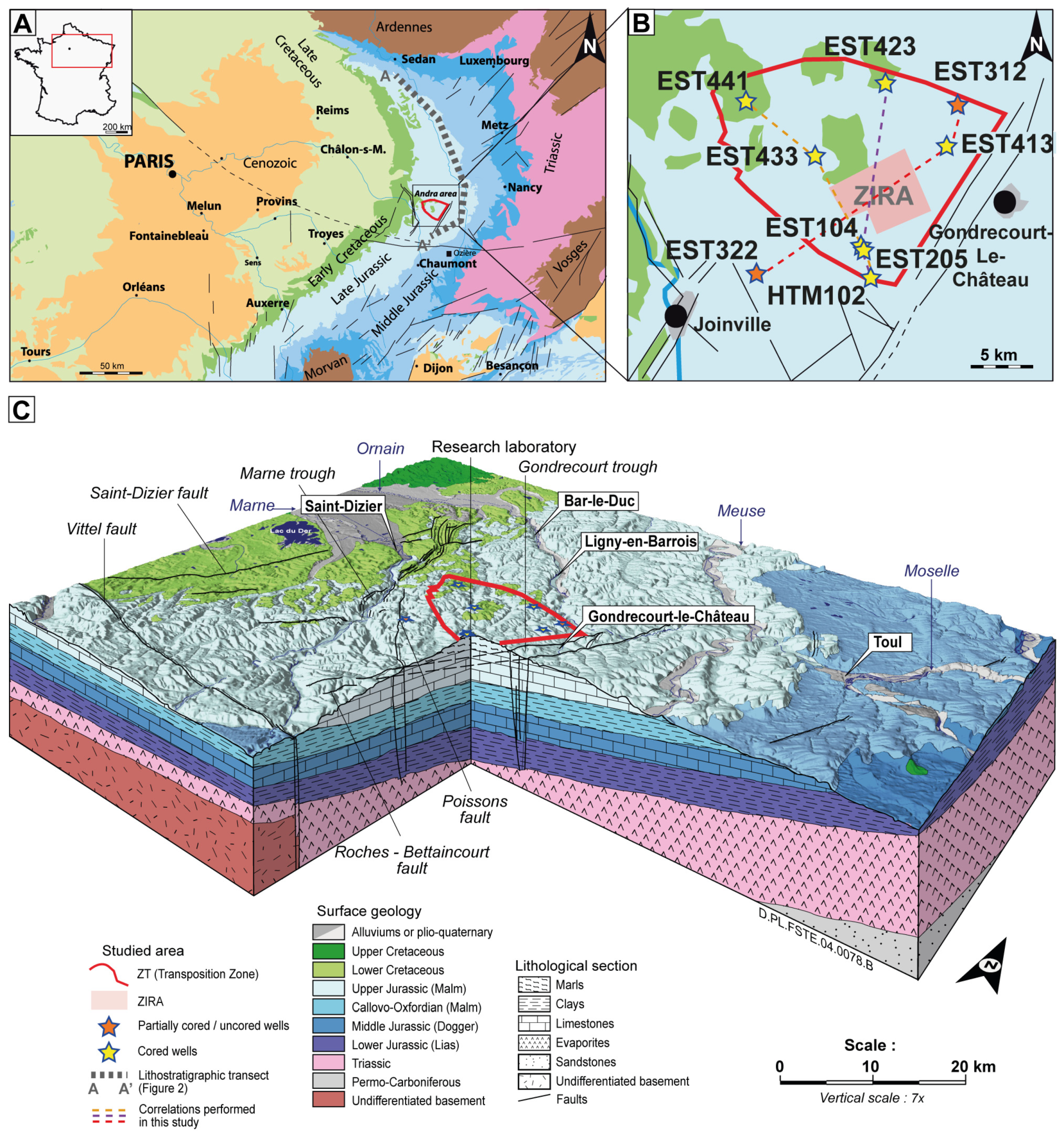

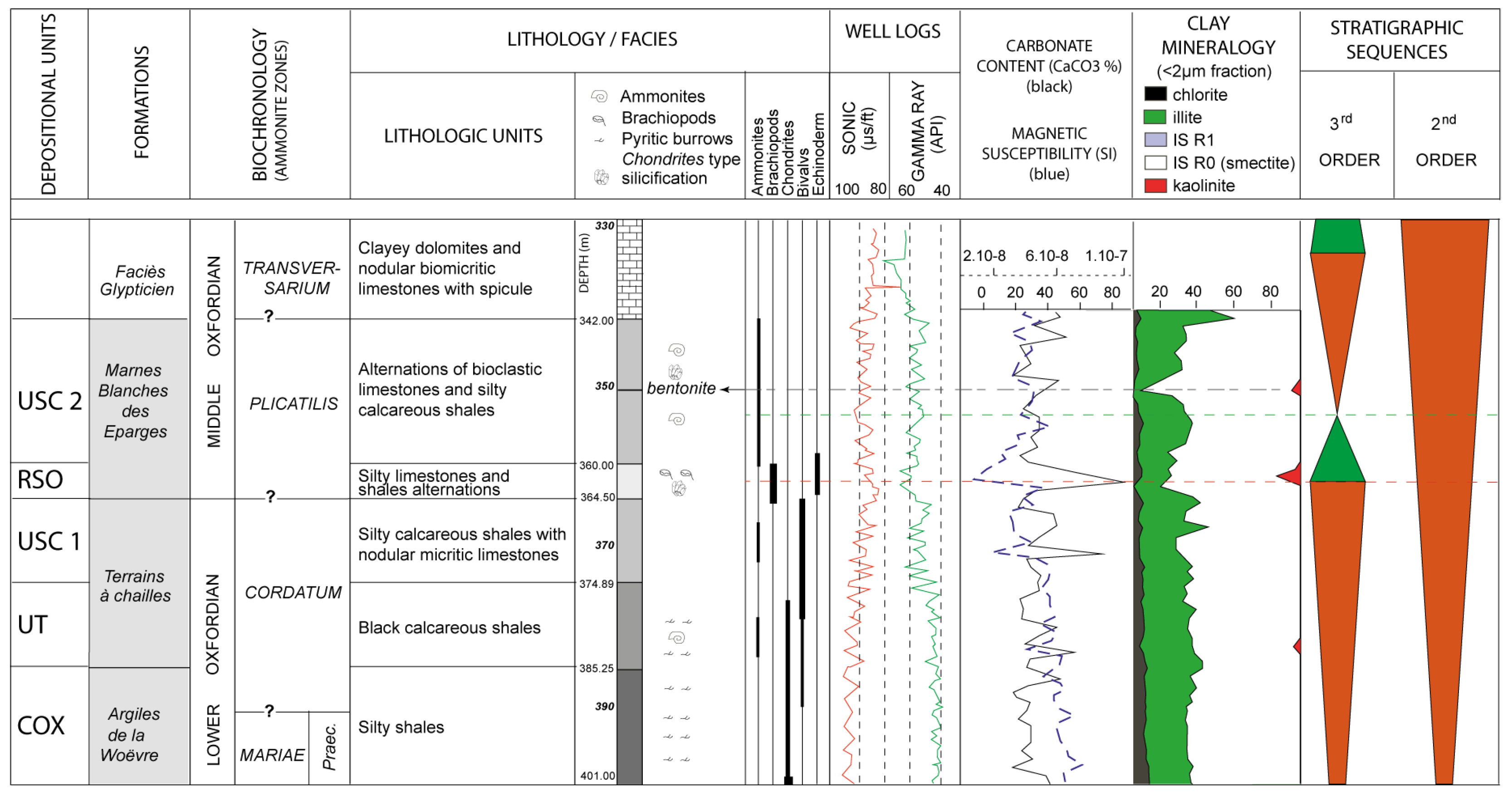
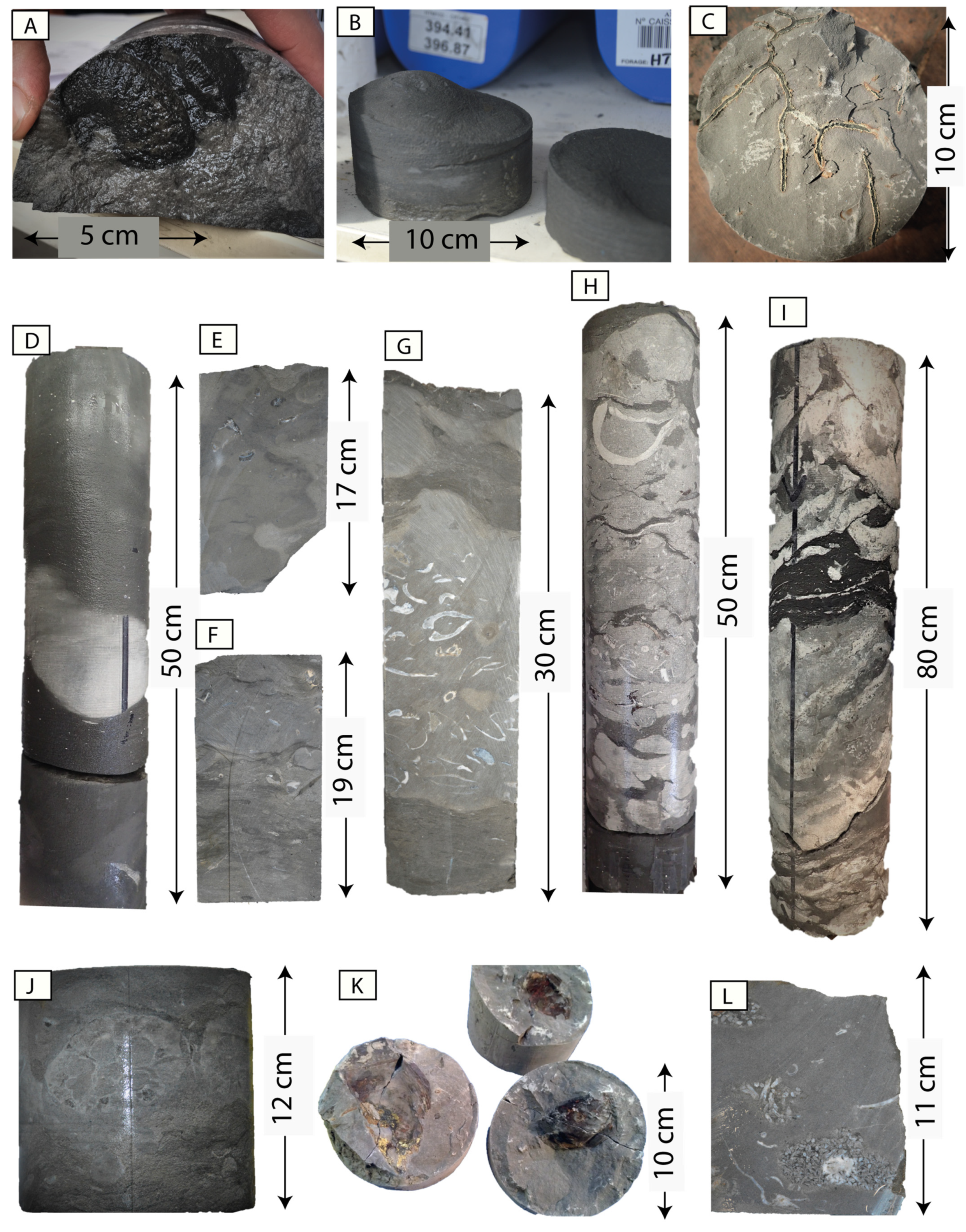
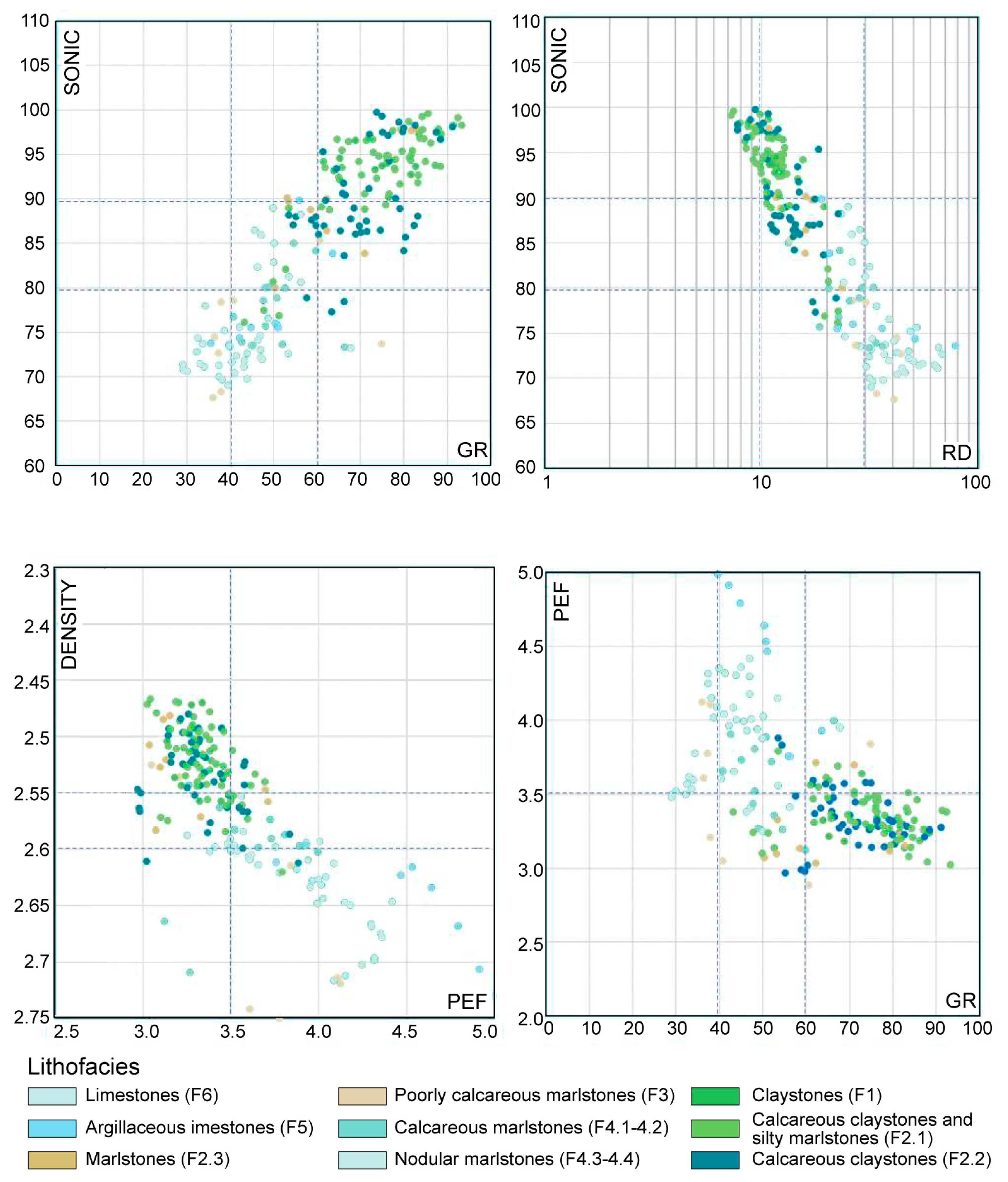
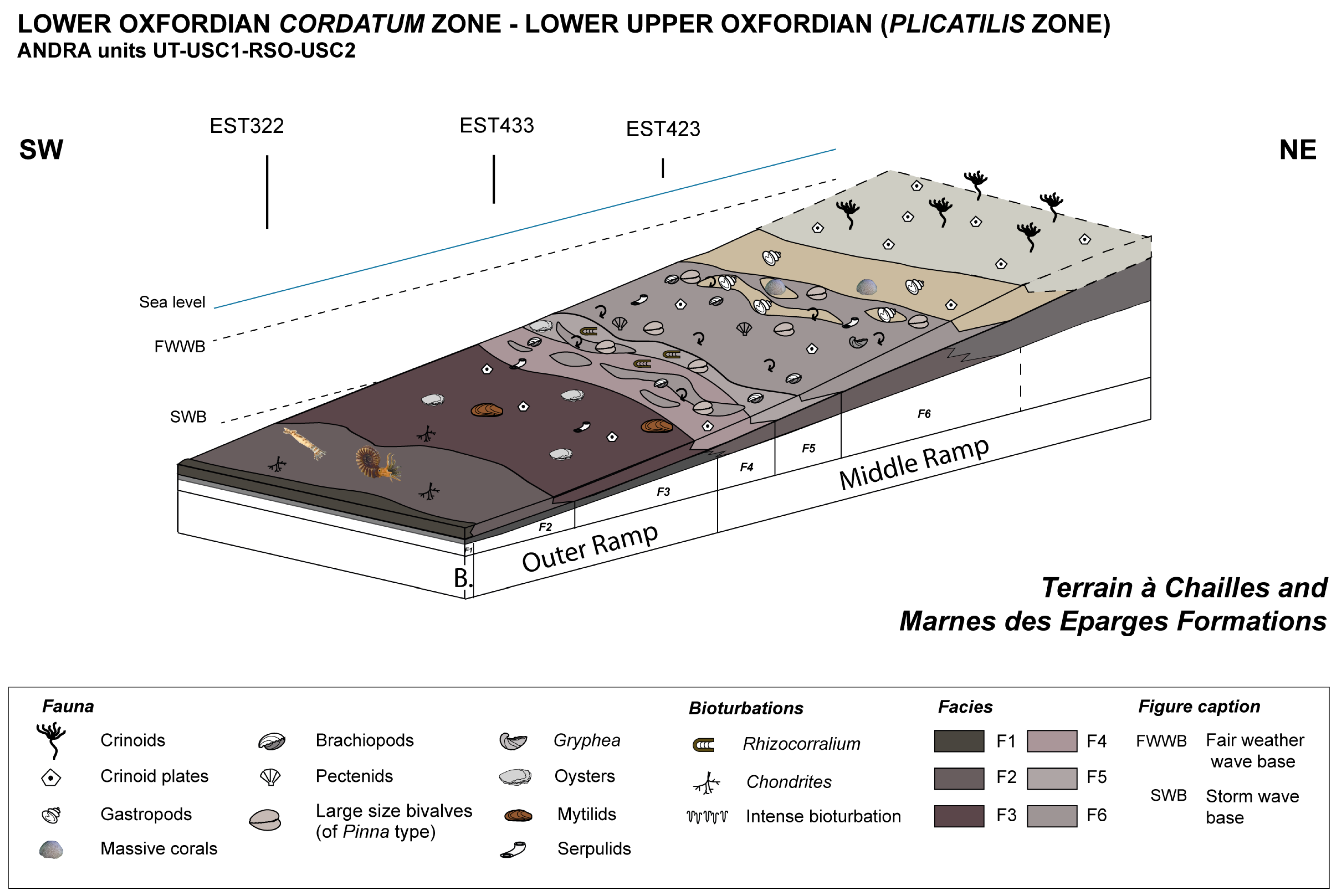
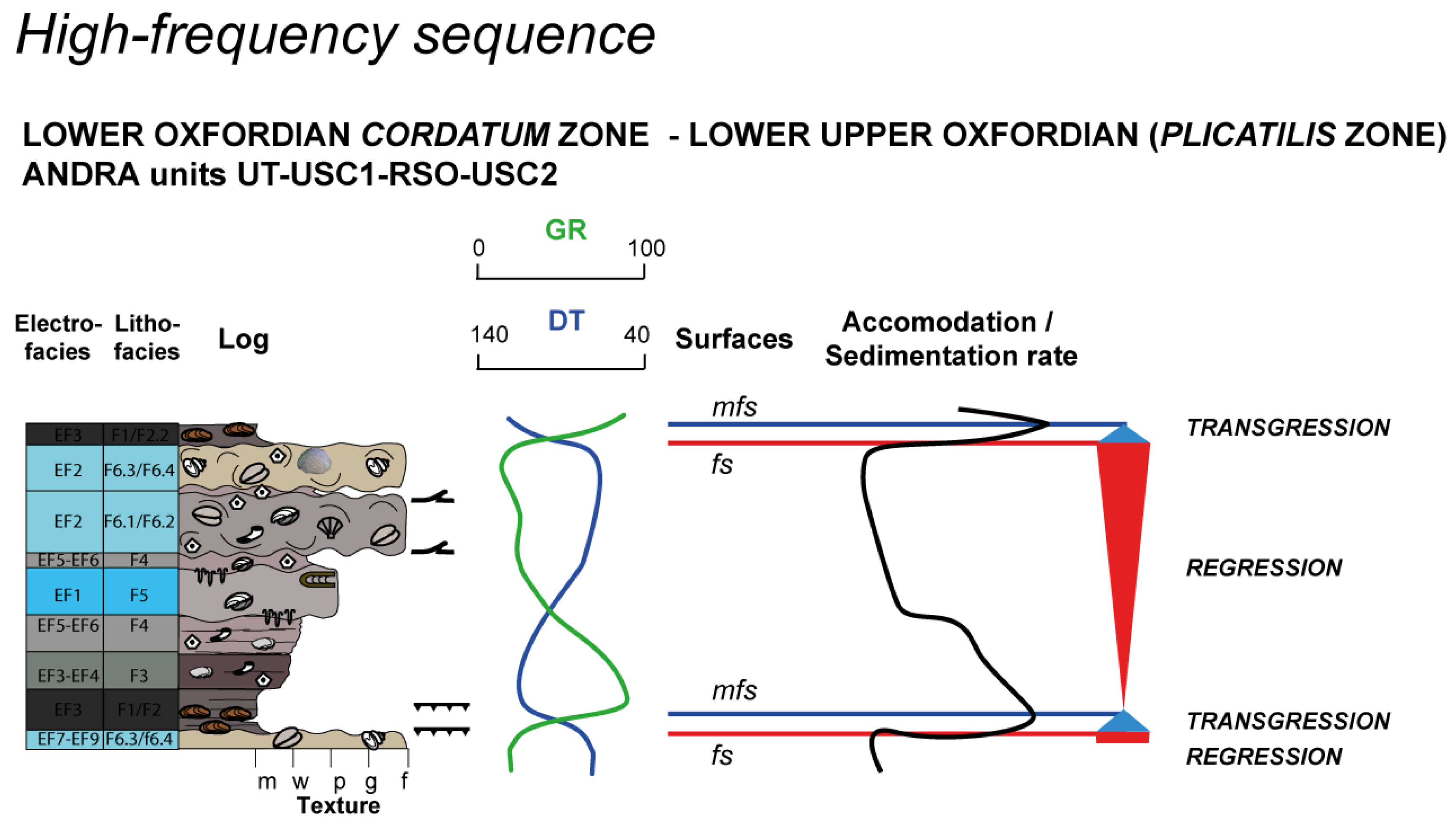
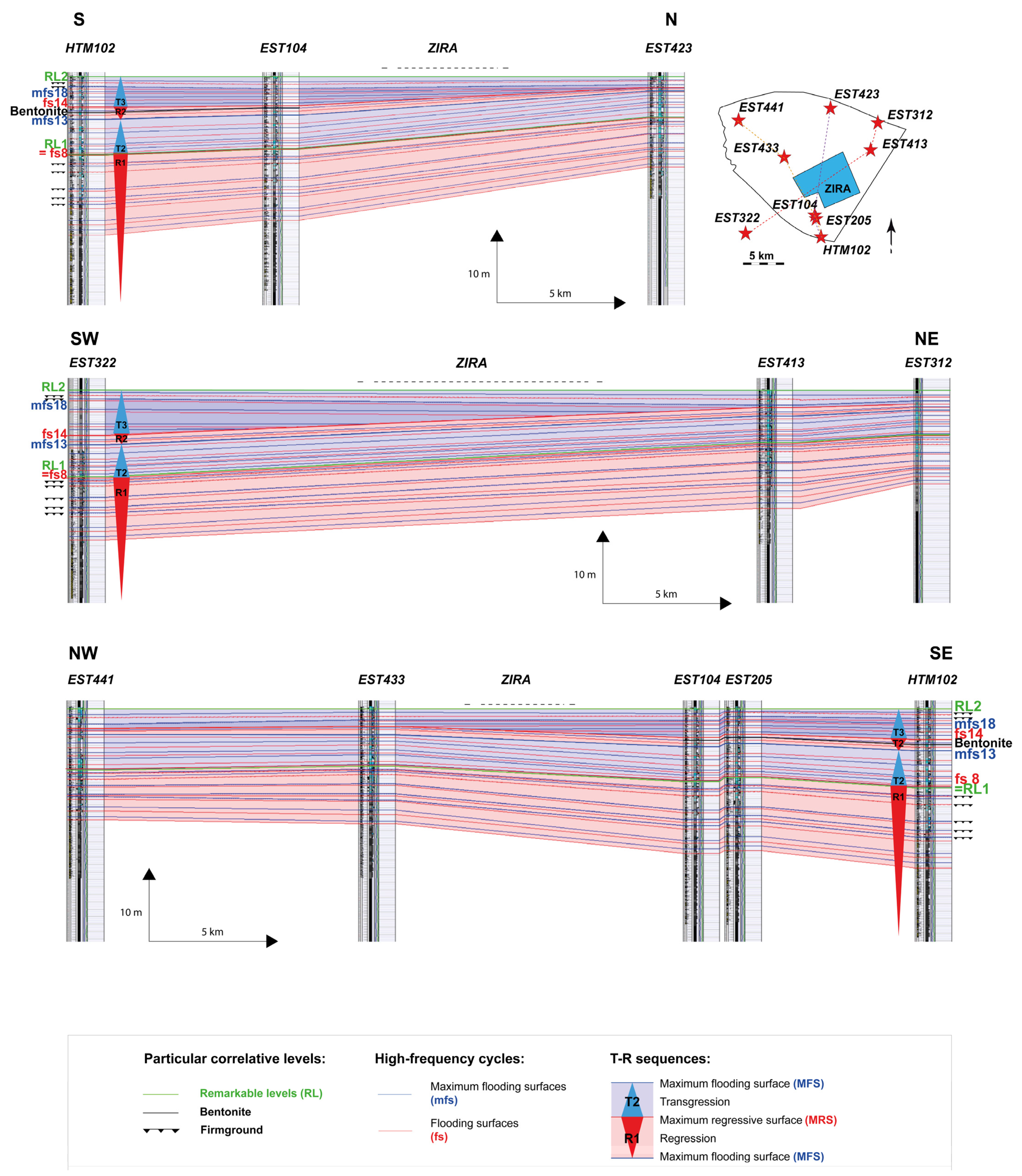
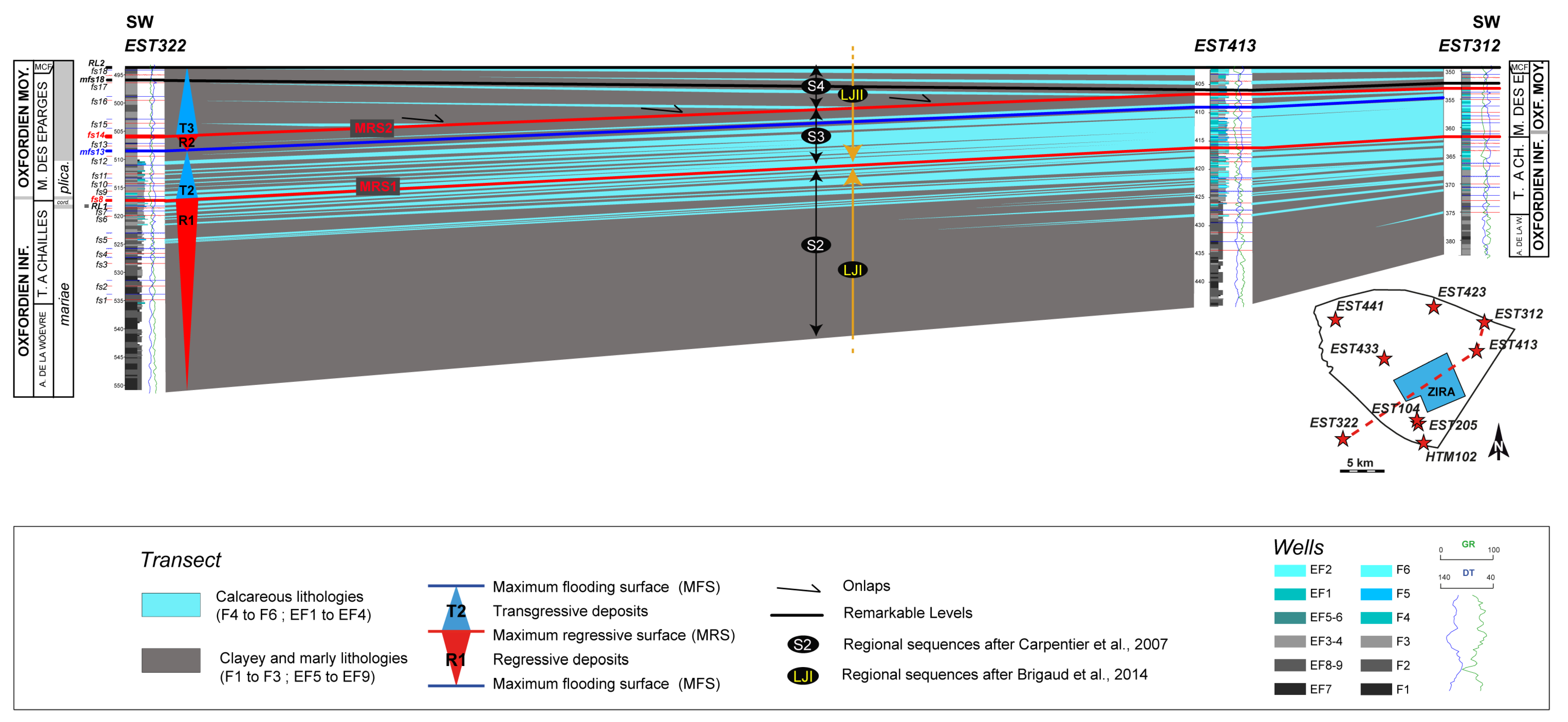
| Facies Assoc. | Lithofacies | Lithological and Textural Characteristics | Faunal Assemblages and Ichnofabrics | Depositional Environements |
|---|---|---|---|---|
| F1 | F1 | • Claystone with horizontal laminations | • Fauna almost absent. Some Chondrites bioturbations are observed (BI = 1) | Basin—sedimentation by decantation in the vicinity of dysoxic environments |
| F2 | F2.1 | • Silty calcareous claystone with horizontal beddings or asymertical ripples | • Rare macrofauna (ammonites, belemites). Some Chondrites bioturbations are observed (BI = 2) | Outer ramp—low energy currents (geostrophic or storms?) in the vicinity of dysoxic environments |
| F2.2 | • Calcareous claystone | • Rare macrofauna (ammonites, belemites). Few calcareous debris are locally observed (small oyster shells and serpulids) | ||
| F2.3 | • Marlstone | • Bioturbation is important (BI = 5), in particular by the ichnognera Rhizocorallium | ||
| F3 | F3.1 | • Silty bioclastic marlstone | • Occurrence of small brachiopods, bivalves and serpulids. Shells are found complete or fragmented | Outer—middle ramp transition—environment under infrequent storm influence and low energy currents |
| F3.2 | • Calcareous bioclastic claystone with storm deposits | • Small brachiopods, bivalves and serpulids. Shells are found complete or fragmented | ||
| F3.3 | • Bioclastic marlstone rich in crinoid plates | • Crinoid plates are abundant. Bivalves and serpulids are equally present | ||
| F4 | F4.1 | • Calcareous marlstone rich in bivalves and/or brachiopods | • Oysters, brachiopods, and other bivalves represent most of the macrofauna. Their shells are sometimes found complete, indicating low transportation from their life environment | Middle ramp—reworked sediment from shallower middle ramp settings |
| F4.2 | • Marlstone with large-size bivalves | • Bivalves of 5 to 15 cm with thin shell (of Pinna type) and gastropods are observed, often complete, indicating low transportation from their life environment | ||
| F4.3 | • Marlstone with calcareous nodules containing large-size bivalves | • Large calcareous nodules containing bivalves of Pinna type | ||
| F4.4 | • Marlstone with other calcareous nodules | • Nodules can include brachiopods and corals, or have a mudstone texture Some micritic nodules are bioturbated, indicating that part of them are linked to depositional conditions | ||
| F5 | F5.1 | • Bioturbated argillaceous limestone of mudstone texture | • Highly bioturbated (BI = 5). Rare shell debris | Middle ramp—low energy environment, bivalves and brachiopods in-situ, nutrient-rich waters |
| F5.2 | • Silty argillaceous limestone poorly bioturbated | • Rare shell debris (BI = 0) | ||
| F5.3 | • Argillaceous limestone rich in shell debris | • Small bivalves, serpulids and brachiopods, are found broken or complete | ||
| F5.4 | • Argillaceous limestone rich in brachiopods | • The fauna is moslty composed of brachiopods | ||
| F5.5 | • Argillaceous limestone rich in oyster shells | • The fauna is moslty composed of oysters | ||
| F5.6 | • Argillaceous limestone rich in bivalves | • The fauna is moslty composed of bivalves of various genera (Ostrea, Pinna, Gryphea, Pectens) | ||
| F6 | F6.1 | • Prominant mudstone limestone poorly bioturbated | • Prominant limestone of mudstone texture, showing partial silification of the matrix (possibly linked to the dissolution of siliceous sponges) | Middle ramp—reworked sediment from shallower middle ramp settings (photic zone—less rich-nutrient waters) |
| F6.2 | • Nodular wackestone/floatstone limestone rich in bivalves | • Most of the fauna is composed of bivalves of Pinna type (i.e., 5 to 15 cm and thin shells). Brachiopods, oysters and gastropods are equally present | ||
| F6.3 | • Nodular wackestone/floatstone limestone rich in gastropods | • Most of the fauna is composed of gastropods and bivalves | ||
| F6.4 | • Nodular wackestone/floatstone limestone containing corals | • Brachiopods, corals, and bivalves of various genera composed the faunal assemblages | ||
| F6.5 | • Packstone limestone rich in crinoid plates | • Flauro faunal assemblages are composed of crinoid plates and bivalves (amongst them numerous oysters). |
| Applied Thresholds | EF | Lithology | Lithofacies | |||
|---|---|---|---|---|---|---|
| Limestone | GR < 40 | Low resistivity | EF1 | Argillaceous limestone | F5 | |
| High resistivity | EF2 | Limestone | F6 | |||
| Marlstone | 40 < GR < 60 | PEF < 3.5 | low resistivity | EF3 | Marlstone | F2.3 |
| high resistivity | EF4 | Poorly calcareous marlstone | F3 | |||
| PEF > 3.5 | RP < 30 ohm.m | EF5 | Calcareous marlstone | F4.1–4.2 | ||
| RP > 30 ohm.m | EF6 | Very calcareous marlstone | F4.3–4.4 | |||
| Claystone | GR > 60 | PEF < 3.5 | RP < 10 ohm.m | EF7 | Claystone | 1 |
| RP > 10 ohm.m | EF8 | Compacted / silty claystone | 2.1 | |||
| PEF > 3.5 | EF9 | Calcareous claystone | 2.2 | |||
Publisher’s Note: MDPI stays neutral with regard to jurisdictional claims in published maps and institutional affiliations. |
© 2022 by the authors. Licensee MDPI, Basel, Switzerland. This article is an open access article distributed under the terms and conditions of the Creative Commons Attribution (CC BY) license (https://creativecommons.org/licenses/by/4.0/).
Share and Cite
Morales, C.; Pellenard, P.; Vincent, B.; Smektala, F.; Daniau, F.; Landrein, P. Stratigraphic Modelling of the Lower/Middle Oxfordian (Upper Jurassic) Outer Ramp Deposits from the NE Paris Basin (France). Geosciences 2022, 12, 375. https://doi.org/10.3390/geosciences12100375
Morales C, Pellenard P, Vincent B, Smektala F, Daniau F, Landrein P. Stratigraphic Modelling of the Lower/Middle Oxfordian (Upper Jurassic) Outer Ramp Deposits from the NE Paris Basin (France). Geosciences. 2022; 12(10):375. https://doi.org/10.3390/geosciences12100375
Chicago/Turabian StyleMorales, Chloé, Pierre Pellenard, Benoit Vincent, Franck Smektala, Fleur Daniau, and Philippe Landrein. 2022. "Stratigraphic Modelling of the Lower/Middle Oxfordian (Upper Jurassic) Outer Ramp Deposits from the NE Paris Basin (France)" Geosciences 12, no. 10: 375. https://doi.org/10.3390/geosciences12100375
APA StyleMorales, C., Pellenard, P., Vincent, B., Smektala, F., Daniau, F., & Landrein, P. (2022). Stratigraphic Modelling of the Lower/Middle Oxfordian (Upper Jurassic) Outer Ramp Deposits from the NE Paris Basin (France). Geosciences, 12(10), 375. https://doi.org/10.3390/geosciences12100375








